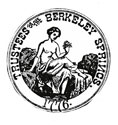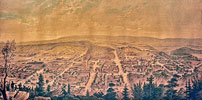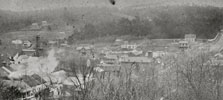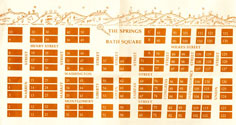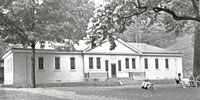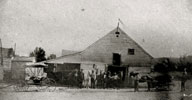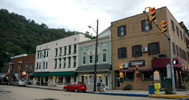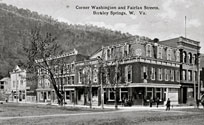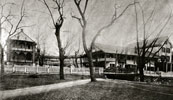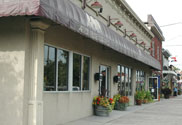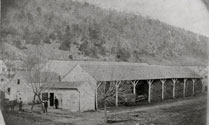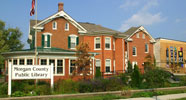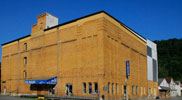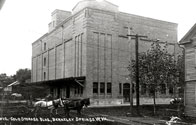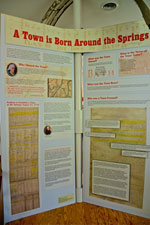Formation of the Town Exhibit– Manual
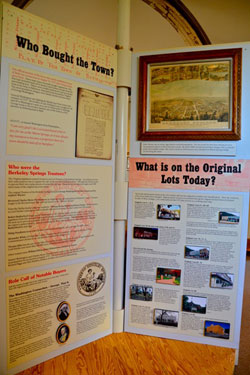 Panels 3 and 4 Who Bought the Town
Panels 3 and 4 Who Bought the Town
(Click on images to view enlargements )
The official auction of the lots in the newly established town of Bath was conducted on August 25, 1777 after being widely advertised. Three main types of people bought original lots:
• land savvy farmers and business people from the surrounding area;
• wealthy landowners and merchants from as far away as Baltimore, Maryland and Alexandria, Virginia.;
• the colonial elite: family, friends and associates of George Washington.
General George Washington was fighting the British near New York in the summer of 1777. His brother-in-law, Fielding Lewis, bought lots 58 and 59 in Washington’s name at a cost of 100 pounds 15 shillings. George wrote to his brother Samuel, one of the trustees, of his pleasure at obtaining land in Bath.
10/27/77….to Samuel Washington from Philadelphia…..
“I am very glad Colo Lewis purchased a lott or two for me at the Warm Springs, as it was always my intention to become a proprietor there if a town should be laid off at that place.”

![]() George owned his two lots in Bath until the end of his life. They were mentioned in his will in 1799:
George owned his two lots in Bath until the end of his life. They were mentioned in his will in 1799:
Bath — or Warm Springs. Two well situated, and had buildings to the amt of 150 pounds. The lots in Bath (two adjoining) cost me, to the best of my recollection, betwn. fifty and sixty pounds 20 years ago; and the buildings thereon 150 pounds more. Whether property there has increased or decreased in its value, and in what condition the houses are, I am ignorant but suppose they are not valued too high.
IMAGE: Deed to George Washington’s lots in Bath, including town plat. Signed by Bryan Fairfax, one of the Trustees of the Berkeley Springs.
Who Were the Berkeley Springs Trustees?
The Virginia Legislature named 14 men to serve as Trustees of the Berkeley Springs. According to the law, their main purpose was to regulate the sale of the lots and building on them. Although they had the power to appoint their own replacements, it seems they did not. Trustees were not appointed again until 1808 when many of the original men were dead.
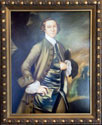
![]() The original Trustees of the Berkeley Springs included George Washington’s brother Samuel and his nephew Warner.
The original Trustees of the Berkeley Springs included George Washington’s brother Samuel and his nephew Warner.
IMAGE: Samuel Washington
Reverend Charles Mynn Thurston was an Anglican minister and patriot in Frederick County, Virginia. Thurston fought in the Revolutionary War and was known as the “Warrior Parson.”

![]() From the Fairfax family came two nephews: Thomas Bryan Martin and Bryan Fairfax. Martin worked as Lord Fairfax’s land agent and eventually inherited Greenway, Fairfax’s estate near Winchester.
From the Fairfax family came two nephews: Thomas Bryan Martin and Bryan Fairfax. Martin worked as Lord Fairfax’s land agent and eventually inherited Greenway, Fairfax’s estate near Winchester.
IMAGE: Bryan Fairfax
Robert Rutherford fought under Washington in the Virginia militia, was the senator in the Virginia legislature from this area and was instrumental in presenting the petition and the law to form the town. He went on to serve as a member of Congress from Virginia. Van Swearingin came from one of the region’s earliest families, owned land along the Warm Springs Road and was connected to Thomas Rutherford by marriage.
Philip Pendleton launched a dynasty that considered Bath its resort through the 20th century.
Alexander White of Frederick County, Virginia was later a member of Congress and one of three Commissioners chosen to lay out the new capital of Washington, DC. He was considered to be one of the most able lawyers in the country.
Thomas Hite was the son of Jost Hite who carried on more than three decades of legal disputes with Lord Fairfax over more than 100,000 acres of Fairfax land that Hite claimed.
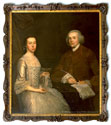
![]() Other trustees were William Ellzey, James Edmundson, and James Nourse.
Other trustees were William Ellzey, James Edmundson, and James Nourse.
IMAGE: James Nourse
Samuel Washington and Charles Mynn Thurston were named to lay out the lots in town in preparation for an auction in August 1777. The town was surveyed by trustee Bryan Martin, Richard Riggs and Alex Stephen, brother of Adam who founded Martinsburg.
Role Call of Notable Buyers
Half the trustees bought lots in the original auction or soon after. Of the more than 100 original buyers, about six were women.
More than a dozen original buyers were family, friends and associates of GEORGE WASHINGTON, first President of the United States. He bought two lots. He had been coming to the springs since his first visit in 1748. He did not visit the springs while serving as president, although he stayed one night on his way to put down the Whiskey Rebellion in 1794. Samuel Washington was a brother and Warner Washington, a nephew. Fielding Lewis married Washington’s sister, Betty. Henry Whiting was a Washington cousin and pre-town resident of Bath while William Ramsey was a trustee for the city of Alexandria, Virginia and married a Washington cousin.
Fielding Lewis![]()
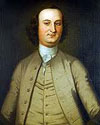
![]() Daniel St. Thomas Jennifer
Daniel St. Thomas Jennifer![]()

Daniel St. Thomas Jennifer was a Washington friend, member of the Continental Congress and signer of the U.S. Constitution. William Herbert was a pallbearer at Washington’s funeral and later served as mayor of Alexandria. James Wilson of Pennsylvania signed both the Declaration of Independence and the U.S. Constitution. He was appointed to the U.S. Supreme Court by President George Washington. James Smith also was a signer of the Declaration of Independence, James Mercer was a member of the Continental Congress and later a jurist. General Horatio Gates was the Revolutionary War hero of the decisive Battle of Saratoga.
![]() James Wilson
James Wilson![]()

![]() James Mercer
James Mercer![]()

![]() Horatio Gates
Horatio Gates![]()
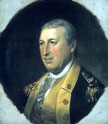
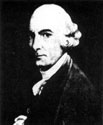
![]() Washington’s relationship with the Fairfax family began in his teens and continued close throughout his life. Fairfax nephews Bryan Fairfax, Thomas Bryan Martin and George William Fairfax retained five lots from the 12 acres deeded them by Lord Fairfax; the remainder was sold in 1777.
Washington’s relationship with the Fairfax family began in his teens and continued close throughout his life. Fairfax nephews Bryan Fairfax, Thomas Bryan Martin and George William Fairfax retained five lots from the 12 acres deeded them by Lord Fairfax; the remainder was sold in 1777.
IMAGE: George William Fairfax
Other notables included Edward Lloyd of Maryland who was one of largest wheat growers in America. Harry Dorsey Gough was another wealthy Marylander and friend to the first Methodist bishop, Francis Asburyand Horatio Gates, both of whom stayed at his house in Bath. Charles Carroll is described on another panel.
The other buyers were:
Mary Ryan Abernathy
Robert Ashby
Thomas Ayers
Elizabeth Baker
John Barns
Thomas Blackbourne
Joseph Booth
William Brooks
Robert Brown
Andrew Buchannon
Philip Bush
Joseph Byrnes
Benjamin Carter *
Peter Catlett *
William Catlett
Frederick Conrad
Jane and Katherine Dalton
Michael Davis
Charles Dick
George Dick
John Donovan
William Drew
Frederick Duckwall Jr.
Frederick Duckwall Sr. •
James Elliott *
Thomazin Ellzey
Thomas Fitzhugh
Edward Fitzpatrick
Windel Freshour *
Nicholas Fleece
Richard Graham
Jonas Grove *
Alpheus Gustin
Christina Gustin
Richard Bennett Hall
William Helms
Richard Henderson
William Herbert
John Higgins *
Judiah Higgins *
Colonel Joseph Holmes
Robert Towson Hose
Samuel Hughes
George Irwin
Thomas Lawson
Edward Lloyd
Dr. William Lyon
Jane McCracken
Angus McDonald
John McDonald
William McMahan *
James Muir
Samuel Neil
James Nourse ••
John Orr
Thomas Palmer
Andrew Pearce •
Daniel Pearce
John Philpot
Sam Purviance
John Ridout
Thomas Ridout *
Michael Rockler
John Scott
Robert Sherrard
John Smith *
William Smith *
Solomon Smith
Henry Snively
Theodorous and Anne Spahar
James Stuart *
Colonel John Stull
John Swaim *
Mathias Swaim *
Capt. John Swann •
Robert Throckmorton Jr.
Rev. Charles Mynn Thurston ••
Dr. John Meade Travers
William Waddell
Hugh Walker *
William Weathers *
Francis Wellis
Matthew Whiting Jr.
Robert Carter Willis *
James Wilson
John Wise
Peter Wise
Charles Yates •
* Signers of the petition to establish the town
** Trustees as well as land owners
A series of mounted signs identify the original lots and their owners. A brochure of the signs is also available. The sign and brochure project was researched and developed by Betty Lou Harmison as a Bicentennial project in 1976.
Authority for seal granted in 1882 in amended and re-enacted charter.
The Constitution of 1872 was drawn up almost decade after West Virginia became a state in 1863. On February 28, the WV Legislature amended the original town charter for Bath and established the first true town government with a mayor, recorder and five councilmen. That form continues today.
Although town government was given the power to erect water works and provide for the purity of the water as well as police the park, all control over the springs and their use remained with the Trustees appointed by the state until the mid-1920s when the springs and surrounding park became a part of state government.
Panel 4 – What is on the Original Lots Today?
John Moray was an artist, sign painter and photographer. For two years he was busy taking pictures of prominent places in the town and county. By April 1889, he had turned these images into a popular print still available today. The view is from an observatory once situated on Warm Springs Ridge overlooking the town. An 1888 photograph, although not identified as Moray’s, captures the views recorded in the lithograph.
Tax books and property deeds in the 21st century still use the original lot numbers for identification. Over the centuries, a few street names have changed. Adjacent parts of town not included in the original lots have been developed. In spite of these changes, you could easily use the 1777 plat of town as a walking map today.
All of the area included in the original plat of the town was named part of the Bath Historic District by the National Register of Historic Places in 2009.
ORIGINAL : Lots 6, 7 & 8 All three lots were purchased by residents of Berkeley and Hampshire counties including Christina Gustin, one of the few women owners. St. Mark’s Episcopal Church was built on lot 6 in 1882-3 by bathkeeper, inventor and builder Henry Harrison Hunter. The rectory next door, also on lot 6, was built in 1888.
NOW: Episcopal Church![]()
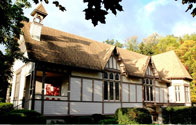
ORIGINAL : Lots 36-40 and south parts of 46 and 47. Desirable locations near the springs, these lots had multiple owners within the first 20 years. Colonel John Strother of Martinsburg assembled them in 1846 and built the famous Berkeley Springs Hotel.
Sketch:19th century Berkeley Springs Hotel.![]()
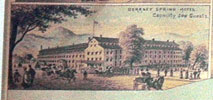
When Confederate General Stonewall Jackson spent two days in January 1862 shelling Hancock, Maryland, he quartered his men and horses in the grand hotel; both Strothers (father, John; son, Adjutant General David Hunter Strother) were well-known Union supporters. The Berkeley Springs Hotel continued as a mainstay of the resort town, famous for its dress balls and band music, until March 1898 when it burned. Only the machine shop and outbuildings survived.
In 1906 and ‘07, there was a merry-go-round on the empty grounds and from 1928 to ‘31 it was used as a tourist campground. After three decades of rumors and false starts by various investors, the local Harmison family built the current center section in 1932 and moved their Park View Inn from its original site across Washington Street the following year. It became so popular, two wings were added in 1937. Since 1972, it has been known as the Country Inn.
NOW: The Country Inn![]()
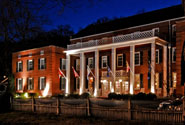
![]() Original section – Park View Inn
Original section – Park View Inn![]()
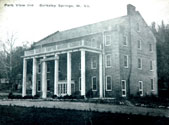
ORIGINAL: Even before the town was established, the core area around the springs was public ground. The two-story Roman Bath House dates to circa 1815 and the Gentlemen’s Springs House on pillars is nearly as old. Both remain looking the same today. The Museum has been located on the second floor of the Roman Baths since 1984.
NOW:![]()
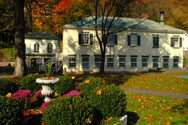
![]() 19th Century Gentlemen’s Springs
19th Century Gentlemen’s Springs 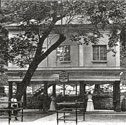
![]()
Surrounding lots were added to the park over the years. In 1795, lots 46 and 47 were owned by Thomas Palmer, a wealthy Philadelphia merchant who willed some of his wealth to be used to cultivate peace and harmony and render war obsolete. In the original auction, Palmer bought lot 48 which was used as a “poor lot” where those unable to afford a place to stay could camp. Sections of 46, 47 and 48 were part of the front entrance of the 19th century Berkeley Springs Hotel and were added to the park when the main bathhouse was built on them in 1929.
The frontage lots — 56, 57, 63 and 64 held lodging houses and hotels until sold to the trustees in 1881 and made part of Bath Square, today’s park. Lots 49 and 50 held elaborate summer cottages in the late 19th century. By 1937 they were demolished by the town and the land purchased by the state as part of the park.
Cottage along west side of park![]()

ORIGINAL: Lots 53, 54, 55 were three of the five lots retained by Lord Fairfax and his nephews. From 1794 through 1900, Fairfax’s small cottage on the property, expanded to a three-story brick dwelling, belonged to the Pendletons, one of the town’s most prominent summer families. Although not an original lot owner, Philip Pendleton was named a Trustee of the springs by the 1776 ordinance. Gill Park was maintained on the unused section of Liberty Street in this area. The Pendleton house became a boarding house known in 1915 as Boleton Lodge. As Kendall House, itwas used in 1929 for the original Park View Inn. In 1932, St. Vincent de Paul Catholic church was built on the eastern lots and in 1964 the old Pendleton house was razed for the rectory.
NOW: Church![]()
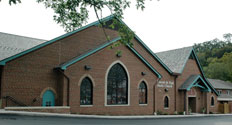
![]() Pendleton/Kendall House
Pendleton/Kendall House![]()
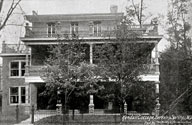
ORIGINAL: Lots 58 and 50 were purchased by George Washington. On September 6, 1784, while visiting in Bath, Washington contracted with James Rumsey to build a house, stables and kitchen on the lots. Rumsey eventually built two rough structures. The lots are described in Washington’s will in 1799; they were bought from the estate by his nephew, Bushrod. Robert Gustin bought the lots from the Bath Trustees in 1825; they had foreclosed because taxes were not paid. In 1868, Judge William Dole — Abraham Lincoln’s Commissioner of Indian Affairs — bought the lots and razed the existing buildings to construct a summer cottage with the town’s first indoor bathroom. The Dole house served as a boarding house through the first half of the 20th century; during the 1930s it was known as the Washington Arms Tourist Home. It was razed in 1952 to build the current dwelling.
NOW:![]()

![]() Dole House construction. Judge Dole looks on
Dole House construction. Judge Dole looks on![]()
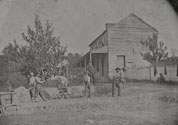
ORIGINAL: Lots 51 and 52 are two of the five lots retained by the Fairfax family. Lord Fairfax had a cottage here that blocked Mercer St. (originally named Montgomery St.) By 1830, the lots were owned by George Washington’s cousin Warner Washington. Legend has it that the area was a red light district in the 18th century where a man might come to “cool his cucumber,” according to town surveyor, Alex Stephen; and location of a pre-Civil War house of ill repute. Hunter Funeral Home on Mercer St. is one of the few remaining 19th century cottages. It was originally called Woodbine when built in 1867 by John De Freese — appointed Government Printer by Abraham Lincoln. Whatever was built there by some Fairfax, was razed to build DeFreese cottage In 1913, Vice President Thomas Marshall visited the De Freese family. It was purchased by the Hunter family in 1936 and renovated as a funeral home. Before it could be used as such, it was volunteered as temporary shelter for victims of the 1936 flood.
NOW: Hunters Anderson Funeral Home![]()
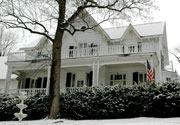
![]() Flood victims – 1936
Flood victims – 1936![]()
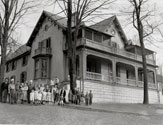
ORIGINAL: Lots 67, 68, 69
Lot 67 was purchased in 1777 by William Ramsey and James Stuart. Ramsey was a trustee of the City of Alexandria and married a cousin of George Washington. In 1903, the Dunn Hotel was built here after razing a livery stable. In 1960, the current structure was built, served as a Post Office and now is part of the County Court complex.
Lot 68 was owned by Frederick Conrad, a Frederick County tanner. Throughout the 19th and most of the 20th century, it was occupied by buildings used for both shops and dwellings.
Early 20th century shops, residences and two-story Dunn Hotel.![]()
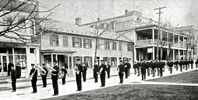
Lot 69 was the property of Robert Rutherford, one of the original town trustees. The County’s second Courthouse was built here in 1845. It was drastically remodeled into the third in 1908 which in turn was destroyed by fire in 2006. A new courthouse opened on the site in 2010.
NOW: Courthouse complex ![]()

![]() Courthouse #2
Courthouse #2![]()
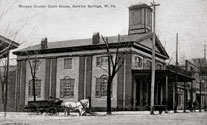
ORIGINAL: Lots 70, 71, A Richard Graham of Prince William County, Virginia owned 70 and 71. Lot A was owned by Robert Sherrard. His widow, Mary Sherrard Abernathy had an early inn on this lot. In 1822, the stone structure was sold to the newly formed Morgan County as the first courthouse and later traded back for lot 69, location of three subsequent courthouses. Most of the area was site of the Fairfax Inn for more than a century followed by commercial buildings still used today. See Fire section of this exhibit for details on two subsequent fires that razed the street in 1901 and 1912.
ORIGINAL: Lots 87, 97 James Wilson of Pennsylvania bought lot 87. He was a signer of both the Declaration of Independence and U.S. Constitution. President George Washington appointed him to the U.S. Supreme Court. During the 19th century, the site held barking sheds and storage as part of the Deford Tannery. In 1906 it was renovated for shops and called the “red building,” a type of shopping mall with bowling alley, shops and restaurants. It was destroyed by fire in 1917. The current building was constructed in 1948 as the town’s first self-service grocery store.
The north corner of the same block was bought by Berkeley County blacksmith William Weathers. He sold it to steamboat inventor, James Rumsey and Nicholas Orrick who operated a store on the lot in 1785. The current commercial structure was built as Bowman’s Department Store in 1962.
ORIGINAL: Lot 86 James Smith was another Pennsylvania signer of the Declaration of Independence. He was a member of the Continental Congress and a militia general. The current Italianate structure was built in 1870 and served for awhile in the 1970s as Town Hall. In 1998, the Morgan County Public Library acquired the building and a large addition was designed to blend with the original style.
ORIGINAL: Lot 94 Hugh Walker of Virginia was one of the largest landowners in town. The site was part of Deford Tannery in the 19th century and then a livery stable. The current yellow pressed brick structure was built as a state-of-the-art apple cold storage facility in 1911. In 1921, the siren whistle for fire alarms was installed on top of the building and continues in use today. The following year, an addition was added to the west side. The corner was part of a tannery in the 19th century, then a livery operation. In 1861, it was an empty lot and site of the only legal hanging in Morgan County history. In 1996, it was given to the Morgan Arts Council and serves as the Ice House art and community center.
click on image to view other section of manual
|
Panels 1 and 2 |
|
A Town is Born Around the Springs |

